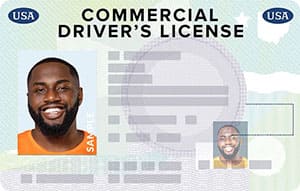- 0 Incorrect (5 allowed to pass)
- 0 Correct
- Updated for February 2025
- Based on 2025 TX commercial driver's license manual
Free Texas CDL Combination Practice Test 2025
You want to be able to drive heavy combination vehicles (like semi-trucks and tractor-trailers) in Texas, right? So you’re studying to pass the official Combination Vehicles knowledge test? We can help! You’ve probably been reading the Texas Commercial Motor Vehicle Drivers Handbook (Texas CDL Handbook 2025). That’s a good first step because the knowledge test is based on this study guide. But maybe you wish you could get some additional help to be sure you ace that test? Great! That’s what we do.
This free Texas CDL Combination practice test, one of several we offer, is also based on the official handbook. Practicing with it will reinforce what you read in the handbook, making it easier to memorize. The practice test is up to date as of February 2025 and contains 25 multiple-choice practice questions. To speed up your learning, our automated assistant can provide you with a hint and an explanation of the correct answer for each question. The practice questions and answers on this test will assess your knowledge of such topics as combination braking systems, combination driving techniques, coupling and uncoupling, and pre-trip inspections. Keep practicing your knowledge with as many of our practice tests as you can, as often as you can, until you feel confident that you can ace that Combination Vehicles knowledge test.
Note that you may have to pass some other official knowledge tests to be able to operate certain types of vehicles or haul certain types of cargo. For example, the Air Brakes knowledge test is a virtual necessity for driving semi-trucks. (Don’t worry; we have practice tests on Air Brakes, too.)
Once you get your CDL of the appropriate class and the endorsements you need for the vehicles and cargoes you’re interested in, you can start driving the roads of Texas to earn money as a commercial driver. You’ll soon become familiar with the major commercial routes: Interstates 10, 35, and 45; U.S. Route 59 (planned to become part of the future extension of Interstate 69); and State Highway 130.
Drivers of semi-trucks and tractor-trailers should find lots of work in Texas. Truckers are in high demand to transport crude oil, natural gas, and energy production equipment. The state’s agricultural sector has created a demand for truckers to haul livestock, cotton, and dairy products, among other agricultural products. The Port of Houston (the Gulf Coast’s largest container port) has created a demand for truckers experienced in intermodal transportation. Finally, the state’s long border with Mexico has made cross-border logistics by trucking increasingly important.
- Perfect for first-time and renewal CDL/CLP applicants, and those adding endorsements
- Triple-checked for accuracy
What you need to know

What to expect on the actual TX DMV exam
questions
correct answers to pass
passing score
Helpful links
List of questions (classic view)
- After you lock the kingpin into the fifth wheel, how should you check the connection?
- After you connect the air lines but before you back under the trailer, you should
- Which statement best illustrates the "crack-the-whip" effect?
- When you inspect the landing gear after uncoupling the trailer, where should the tractor be?
- What is the safest way to turn right from a two-way road?
- To drive a triple combination vehicle, you must have
- To prevent a rollover, cargo should be
- Combination vehicles take longer to stop when they are empty than when they are fully loaded, because
- If your vehicle gets stuck on a railroad track, you should
- Low-slung vehicles can be risky at railroad crossings because
- On a double or triple vehicle, which wheels offtrack the most?
- When you're pulling doubles or triples, the shut-off valves should always be
- On a trailer, where is the yellow antilock brake (ABS) malfunction lamp located?
- Even before antilock braking systems (ABS) were required, some vehicles already had them. How can you check if your vehicle has ABS?
- An antilock braking system (ABS) is useful
- After coupling, make sure that the air lines are not crossed. How should you do this?
- During uncoupling, you should disconnect the electrical cable and
- Before you start to uncouple, you must
- You can confirm that air is going to all brakes in your trailers by
- To uncouple a loaded trailer, after the landing gear has made firm contact with the ground, you should
- If the trailer has antilock brakes (ABS) but the tractor doesn't,
- To test the tractor protection valve, charge the trailer air brake system, turn off the engine, and
- If your test of the tractor protection valve is successful,
- The tractor protection valve is designed to close automatically if the air pressure falls into the pressure range specified by the manufacturer, typically
- As part of your vehicle inspection test, if your vehicle is equipped with air brakes and has a trailer, you will inspect the air connections between the truck or tractor and the trailer. Make sure that the ________ are locked in place and free of damage or air leaks.
- Alabama: Test 1 / Test 2
- Alaska: Test 1 / Test 2
- Arizona: Test 1 / Test 2
- Arkansas: Test 1 / Test 2
- California: Test 1 / Test 2
- Colorado: Test 1 / Test 2
- Connecticut: Test 1 / Test 2
- Delaware: Test 1 / Test 2
- District of Columbia: Test 1 / Test 2
- Florida: Test 1 / Test 2
- Georgia: Test 1 / Test 2
- Hawaii: Test 1 / Test 2
- Idaho: Test 1 / Test 2
- Illinois: Test 1 / Test 2
- Indiana: Test 1 / Test 2
- Iowa: Test 1 / Test 2
- Kansas: Test 1 / Test 2
- Kentucky: Test 1 / Test 2
- Louisiana: Test 1 / Test 2
- Maine: Test 1 / Test 2
- Maryland: Test 1 / Test 2
- Massachusetts: Test 1 / Test 2
- Michigan: Test 1 / Test 2
- Minnesota: Test 1 / Test 2
- Mississippi: Test 1 / Test 2
- Missouri: Test 1 / Test 2
- Montana: Test 1 / Test 2
- Nebraska: Test 1 / Test 2
- Nevada: Test 1 / Test 2
- New Hampshire: Test 1 / Test 2
- New Jersey: Test 1 / Test 2
- New Mexico: Test 1 / Test 2
- New York: Test 1 / Test 2
- North Carolina: Test 1 / Test 2
- North Dakota: Test 1 / Test 2
- Ohio: Test 1 / Test 2
- Oklahoma: Test 1 / Test 2
- Oregon: Test 1 / Test 2
- Pennsylvania: Test 1 / Test 2
- Rhode Island: Test 1 / Test 2
- South Carolina: Test 1 / Test 2
- South Dakota: Test 1 / Test 2
- Tennessee: Test 1 / Test 2
- Texas: Test 1 / Test 2
- Utah: Test 1 / Test 2
- Vermont: Test 1 / Test 2
- Virginia: Test 1 / Test 2
- Washington: Test 1 / Test 2
- West Virginia: Test 1 / Test 2
- Wisconsin: Test 1 / Test 2
- Wyoming: Test 1 / Test 2
Your go-to, trusted source
Experience the Driving-Tests differenceOur commitment to accuracy and quality in our practice tests
Explore our rigorous, multi-tiered verification process that ensures each question mirrors the official manual for unparalleled accuracy.

At Driving-Tests.org, we understand the importance of reliable and accurate practice tests to help you prepare for your DMV exam. That's why we've developed a meticulous process to create and continually update our practice questions, ensuring they reflect the most current driving laws and regulations.
Here's an inside look at how we maintain the highest quality in our practice tests.
Content Creation and Verification Process
- Alignment with Official Manuals:
Every question we develop is based on the most recent version of each state's official driving manual. Our team regularly monitors each state DMV's website for the latest updates to ensure our practice tests are always aligned with the most current information. - Community Feedback Integration:
We leverage feedback from our vast community of users to understand which topics are most frequently tested. This helps us focus on the areas that are most relevant and beneficial for your preparation. - Expert Content Creation:
Our in-house editor, Steven, who has extensive experience in driver education, crafts each question with precision. He conducts a thorough review of each question against the official manuals to ensure accuracy. - Rigorous Review Process:
Once Steven has finalized a set of questions, our team conducts a joint review session. This second level of scrutiny involves content accuracy, proofreading, and fact-checking to eliminate any errors. - User Feedback Mechanism:
After a question goes live on our site, we keep the lines of communication open. Each question features a feedback button, inviting users to report any issues or errors. This continuous feedback loop allows us to address and rectify any concerns promptly. - Responsive Updates:
In line with our commitment to accuracy, we quickly update our practice questions to reflect any changes in the DMV manuals. Additionally, we update the free electronic copy of the state's driver's license manuals on our site, typically within a few days after the DMV publishes them.
Our thorough quality control process ensures that you have access to practice tests that are as accurate and up-to-date as possible. We believe in the power of well-prepared drivers and are dedicated to providing you with the best study tools to help you succeed on your DMV exam.
Get your ELDT certificate and pass CDL exams the first time. Guaranteed.
Get full access to our 3-in-1 program, starting at $79. CDL schools charge $3,000-$4,000 for that.
All 1,500 TX exam-like questions
Pass Guarantee: pass your permit exam, or get your money back
ELDT certification included
Official FMCSA-approved provider, instant completion reporting
Industry-leading 99.06% success rate
Compare with the average US passing rate of 49%
Trusted by over 1.15 Million customers
The only program recommended by DMVs






